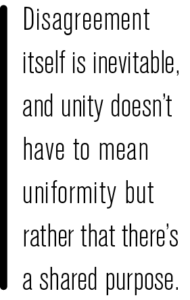The ability to resolve real estate team conflicts is a skill that all brokers should develop
By Jason Henninger
Few settings are as inherently frustrating and unfulfilling as being on a disunified team. Not everyone is a team player, but even those who aren’t naturally drawn to a group dynamic prefer a team where people get along over one that feels like it’s falling apart. It starts with a snide comment here, an unhelpful complaint there, and before you know it, the energy that could be used toward fulfilling the goal gets wasted keeping the group in one piece.
All of this adds pressure to the people leading the group. How do things slide out of control? And how do you reclaim the peace and get things back on track?
Maria Dargan, CRS, broker associate at REMAX Revolution in Wall, New Jersey, has participated in and led plenty of teams that have run the gamut from cooperative to disjointed and angry. A bad team, she says, is marked by conflict and animosity. “People start going in different directions and lose focus of the goal.”
Dargan says the initial cause of disunity is simply a matter of differing personalities. One person just doesn’t like how another works or talks, and the issue starts grating between people until the complaints and bickering begin.
Before long, people on the team start to take things personally, which Dargan says is something she always tried to curtail. “I tell everyone, ‘Nothing is personal. You have your set of ideas, and this individual has theirs. We have to come together and figure it out.’ You have to make sure that you eliminate any kind of stress and resentment from the conversation right off the bat. They need to understand all sides and remember that there is a common goal here that we cannot overlook,” she says.
Trouble on the horizon
Dargan says to watch out for the early signs of unrest. It could be that one person doesn’t want to be near another or tenses noticeably when the other enters the room. It could be one person shutting another down over and over. Disagreement itself is inevitable, and unity doesn’t have to mean uniformity but rather that there’s a shared purpose. “As a leader, you have to pull everybody back in,” she says. Bickering and sidebar conversations can turn a normal meeting into a noisy and uncomfortable event. “You have to say, ‘OK, enough, let’s get back to what we were discussing.’”
The role of a team leader is more than just squashing conflicts when they pop up. Part of the job is being proactive in establishing communication protocols. Clear communication paths laid down at the outset of any working relationship allow team members to feel secure in their ability to raise concerns without fearing they’ll be shut down or belittled into changing positions. Such rules of order as establishing the flow of conversation, time allotted to each speaker, formatting ways to introduce alternatives to other’s ideas or defend one’s own position all serve to keep the discussion on topic and not get lost in matters of personality. And they do so before the conflict arises.
 Lead, don’t take sides
Lead, don’t take sides
It is also crucial, Dargan says, for the team leader to remain neutral and calm. “Never take sides in a conflict,” she says. Even if, in the leader’s mind, one person is right and the other is wrong, you handle it with neutrality. “Do you say, ‘You’re right,’ and ‘You’re wrong?’ Absolutely not. You encourage the individuals to discuss whatever topic and come to a mutual understanding,” she says. Active listening is helpful, but choosing sides is not.
In situations where established rules of order and neutrality don’t completely diffuse the tension, there are other options.
Press the reset button: First, you can realize that things are too derailed and that the purpose of the meeting has been lost. If this happens, it may be helpful to stop the meeting and hope that cooler heads will prevail next time rather than try to force the issue and risk escalation of the problem.
Mediation: Another useful tool for ongoing personality conflicts is mediation. A third party not directly involved in the conflict (and ideally of some sort of higher rank in the organization) steps in to listen fairly and dispassionately while people air their grievances. Even if you are a perfectly neutral leader, having someone outside the team to mediate provides a helpful layer of distance from the conflict itself to dispel any chance of bias.
Remove a team member: The last option is to remove a person from the team, which should be avoided if possible. Even when necessary, taking someone out of the team is disruptive and leaves a gap in bandwidth. A far better solution is to have a clear goal that all team members can count on as a focal point, to bring them back to the prime point of the team, rather than cutting someone out and losing the valuable perspective they could provide.
“Each individual we welcome to our team brings something important to the table,” Dargan says. “I may not agree 100% with each person or their thought process. But I’m going to be open to whatever they’re talking about, and then I’m going to make the best decision possible for the whole team’s benefit.”
Build your ideal team with help from our upcoming webinar, Making Your Team Click, hosted by CRS Certified Instructor Mike Selvaggio. Register today at CRS.com/education/education-catalog.
Photo: Getty Images/StudioM1








